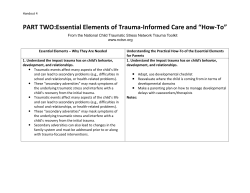
Outline Abdominal and Retroperitoneal Sonography • Sonography in trauma - FAST exam
Outline • Sonography in trauma - FAST exam Abdominal and Retroperitoneal Sonography – Indications – Limitations – Techinique • Vascular Ultrasound – Aorta Dana Sajed, MD Massachusetts General Hospital What Is It? A limited ultrasound examination for the detection of free fluid in the torso in the setting of trauma or hypotension Focused Assessment with Sonography in Trauma E-FAST Extended FAST Involves scanning to detect: • Pneumothorax or • Fluid in the thorax Focused Questions The FAST exam answers very specific questions: 1) Is there free fluid in the peritoneum? 2) Is there fluid in the pericardium? 3) Is there fluid in the thorax? – Epidemiology – Technique – Clinical Protocol Evaluation in Trauma • CT: Non-invasive, gives detail about organs… but is also expensive, not always available, involves transport of potentially unstable pt away from ER, ionizing radiation • DPL: Very sensitive… invasive, uncomfortable for pt, complications can be devastating • US: Less sensitive… but specific, non-invasive, can detect 250cc of free fluid, performed at bedside Limitations • The FAST exam does NOT identify specific organ lesions • Poor test for detection of retroperitoneal bleeding • Does not distinguish blood vs other types of fluidascites, bladder perforation, ruptured cyst • Does not tell you the source of bleeding • May be technically limited - obesity, post-op patients, subcutaneous emphysema, etc… 1 Advantages • Performed rapidly at bedside • Noninvasive • Inexpensive • Easily repeated • Highly specific for therapeutic laparotomy in blunt trauma Indications for FAST Exam • Blunt Abdominal Trauma • Penetrating Cardiac Trauma – detect effusion, tamponade • Thoracic Trauma – PTX, HTX • Penetrating Abdominal Trauma – less sensitive for detecting need for laparotomy • Polytrauma – may help prioritize management • Mass casualties – Armenia 1988, Turkey 1999 • Undifferentiated Hypotension – E-FAST Why FAST works Four Views of the FAST Exam Pericardium Fluid pools in predicable locations in the abdomen: Subhepatic Perisplenic RUQ Perinephric Pelvic LUQ Pelvis Subpleural Anatomy: RUQ RUQ Probe placed around 8-11th rib space, mid-axillary line R Kidney Liver ( Morison’s Pouch Fan probe to capture retroperitoneal structures View Includes Liver Kidney – must include inferior pole! Morison’s pouch Diaphragm and Lung (E-FAST) 2 Liver RUQ RUQ RUQ RUQ Optimizing the RUQ View Optimizing the RUQ View Morison’s Pouch Kidney Diaphragm Place pt in trendelenburg – fluid will flow towards the potential space Rib shadow • May need to slide probe around rib • Rotate probe obliquely to avoid shadow • Have pt take deep breath and hold If unable to obtain adequate midaxillary view: • Reposition probe anteriorly • Same image obtained due to large acoustic window of liver 3 Left Upper Quadrant • Probe at left posterior axillary line • 6-9th rib space • Examine for: – Fluid in splenorenal recess – Fluid in subdiaphragmatic space – Fluid in left pleural space LUQ Splenocolic Ligament LUQ LUQ LUQ LUQ Spleen Kidney Diaphragm Free Fluid 4 LUQ LUQ Spleen Kidney The “gastric fluid” sign: an unrecognized false-positive finding during focused assessment for trauma examinations. Nagdev A, Racht J. Am J Emerg Med. 2008 Jun;26(5):630.e5-7 LUQ Difficulty obtaining LUQ images • The spleen is much smaller than the liver and gives less of an acoustic window • Bowel gas and stomach bubble may create interference LUQ • Try angling the probe obliquely to sneak in between the ribs • Have the patient take a deep breath to lower the diaphragm and bring spleen and kidney below ribs • Most common mistake is usually not starting superior enough or posterior enough • Rib shadows, obesity, etc. Pelvis In male, free fluid seen posterior to the wall of the bladder Rectovesical space Pelvis Rectouterine Pouch (of Douglas) Vesicouterine Pouch 5 Pelvis • Ideally done before foley is placed or bladder is emptied • Two views to obtain Transverse Longitudinal (Sagittal) • Probe is placed on symphisis pubis, aimed caudad Transverse Pelvis Probe in the midline just cephalad to the pubic bone Probe indicator pointed to pt’s right Pelvis Bladder Ovary Pelvis Free Fluid Ovary Uterus Pelvis Pelvis 6 Pelvis Pelvis Longitudinal (Sagittal) Suprapubic View Longitudinal View Probe in the midline just cephalad to the pubic bone Aim towards feet Sagittal Pelvis Sagittal Pelvis Sagittal Pelvis Pelvis Difficulty identifying the bladder: Free Fluid • Most often, the probe is too cephalad – bring the probe almost on top of the symphysis pubis and angle toward the feet • If the bladder is empty- saline in through foley catheter • If no foley, give IV fluids • Bladder may not be in midline – slide to obtain images on the sides Place pt in reverse trendelenburg 7 Controversies and Future Directions • Randomized trauma patients to FAST protocol vs. trauma evaluations without FAST • FAST patients had - More rapid time to OR - Fewer CT scans - Complications - Decreased length of stay - Fewer hospital charges FAST in penetrating trauma • Studies indicate about equal sensitivity for detecting hemoperitoneum as in BAT • High specificity • Assessment for violation of abdominal wall • Within minutes it allows clinicians to concentrate efforts on a cardiac, chest and or intraperitoneal injury Controversies and Future Directions FAST in penetrating trauma • Despite high specificity, poor predictor of need for laparotomy • Unnecessary in the unstable patient with penetrating trauma • Can not evaluate bowel injuries, which are common in pen. trauma ABDOMINAL AORTA Epidemiology - AAA • 13th leading cause of death in USA – 15,000 deaths per year • 1-3% of deaths among males 65-85 Risk Factors • Male • Atherosclerosis – One million in USA > 65 yo have a AAA • 7:1 M:F • 65-85% mortality overall – Half of these never make it to the OR • Mortality significantly reduced with screening and elective repair • Smoking • Hypertension • Age 8 Signs and Symptoms “There is no disease more conducive to clinical humility than aneurysm of the aorta.” • Usually asymptomatic until they expand or rupture • Pain - low back, flank, abdominal, or groin – Classically sudden, severe – Often associated with nausea, vomiting William Osler, circa 1900 • Rupture - Shock, hypotension, tachycardia, syncope, AMS, cardiovascular collapse Indications • Suspected AAA Bedside Ultrasound • Fast and it saves lives • Pulsatile abdominal mass • Unexplained hypotension/ CV collapse – Average time to diagnosis by bedside US = 5.4 min – Average time to diagnosis by CT = 83 min • Elderly Patient? – Average time to OR for diagnosis by US = 12 min – Unexplained back/flank pain – Unexplained hematuria – Average time to OR for diagnosis by CT= 90 *Plummer min* et al Abstract presented at 1988 ACEP Scientific Assembly Anatomy Aneurysm • 85% are inferior to the renal arteries • Can occur at the bifurcation, or beyond bifurcation into common iliacs • Two main forms: Fusiform Saccular 9 Views of the Aorta • Transverse: – Proximal – Mid – Distal – Bifurcation • Longitudinal – Look infra-renal Goals of Bedside Ultrasound • Yes or No answer to two questions – Is abdominal aorta > 3 cm – Are iliac arteries > 1.5 cm THIS IS WHAT YOU MUST KNOW Technique • Ideally, want to use curvilinear (low frequency) probe • Can use phased array probe as well Technique • Obtain transverse and longitudinal images along the entire course of abdominal aorta • Measure outer wall to outer wall in two planes • Use vertebral shadow as reference point • Apply gentle, constant pressure to remove bowel gas Proximal Aorta • Start immediately below the xiphoid process • Identify the vertebral body • Identify the SMA Splenic Vein SMA Ao Vertebral Body 10 Mid Aorta • Slide probe to the umbilicus • Slide the probe caudally in the midline • The aorta follows the curvature of the spine, more anterior • Again identify the aorta anterior to the Distal Ao and Bifurcation • Then aim caudally Ao • Measure both the distal aorta and the common iliacs Spine Longitudinal Aorta Longitudinal Aorta • Visualize the aorta in the long axis • Look infrarenall y 11 • Aorta lies more anterior caudally; to get true crosssection must angle probe • Calipers should be at 90 degrees to the vessel for most accurate measurement Measuring the Longitudinal Aorta • Cylinder tangent effect can lead to off-axis measurement • In sagittal plane pan through aorta and measure maximal diameter • Remember to measure OUTER WALL to OUTER WALL of the aorta • This is done to not miss a false lumen Bifurcation – Iliac Aneurysm 12 Questions Answered By Bedside Ultrasound • Is there an abdominal aortic aneurysm? – Aorta >3cm – Iliac >1.5cm • Remember that 85% of aneurysms are inferior to the renal artery • Remember the longitudinal axis Pitfalls • No real contraindication - delaying immediate surgical care • Imaging errors – Scan through the entire plane, so as not to miss saccular aneurysm • Patient factors – body habitus, bowel gas – apply gentle compression • Failure to image iliacs AAA Clinical Protocol Clinical Suspicion of AAA? Aorta > 3 cm No AAA ruled out OR Iliacs > 1.5 cm? Yes Hemodynamically unstable? No CT Yes To OR! 13
© Copyright 2025





![[ PDF ] - journal of evolution of medical and dental sciences](http://cdn1.abcdocz.com/store/data/000670893_1-7a17ba26d33efa9aee8c022192eaa7f4-250x500.png)




